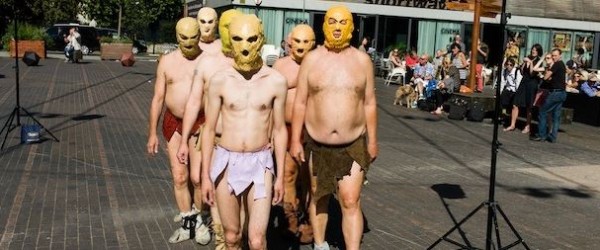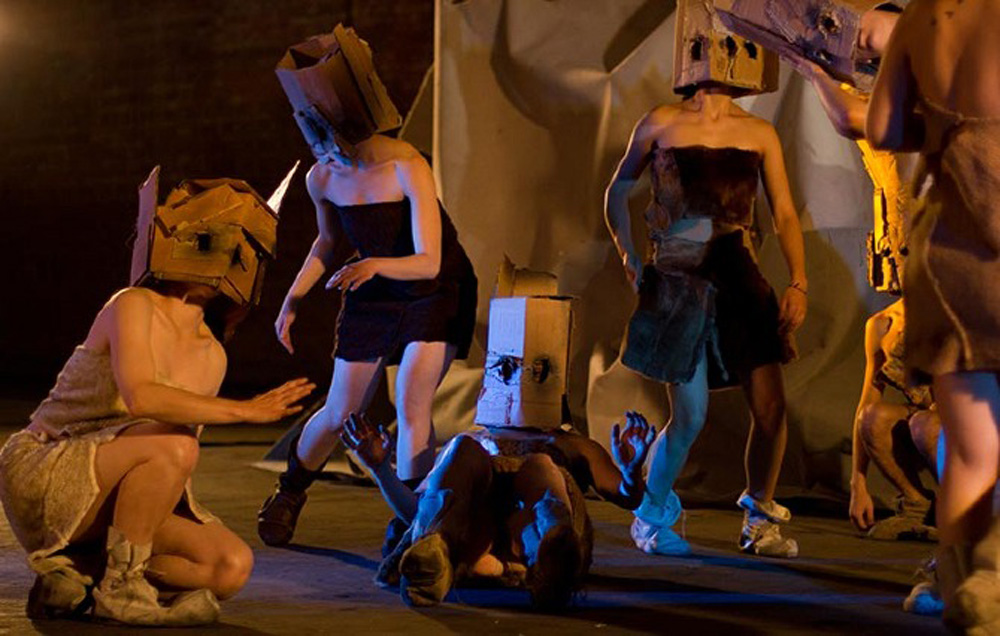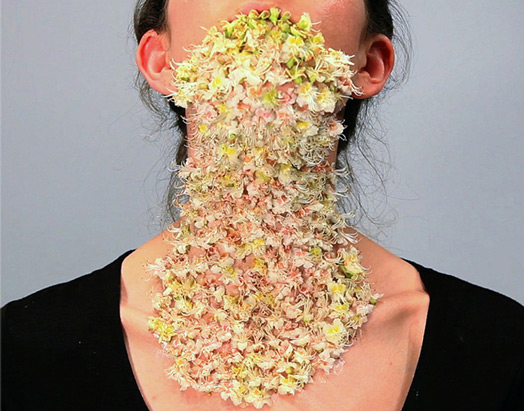
Artist Interview: The Birth Caul
Art, Artists, Fine Art, InterviewsA conversation with Miriam Austin and Adam James, the artistic duo behind ‘The Birth Caul’; a new exhibition and program of events at VITRINE Bermondsey Square.
Zouch: Tell us about your pairing for the show – how did it come about and how has it further developed into a collaborative relationship?
Adam James: It all started with a conversation between Jordan [McKenzie, co-curator] and I after a particularly rowdy performance of mine at LUPA [Lock Up Performance Art]. Jordan suggested I show ‘something’ with ‘someone’ at Vitrine gallery… given (a) I had just trashed Jordan’s garage with nine semi-naked drunks and (b) my recent decision to say yes to everything, I gladly accepted.
Shortly after, Miriam and I were dropped into the melting pot and it didn’t take long to suss out our common ground. Like a pair of giddy children we cackled about the religions (amongst other things) that we were both attempting to start; Miriam’s in a wooden dome on the roof of a Peckham multistory car park and mine somewhere in a leafy glen of Sherwood Pine Forest. We continued to hop, skip and jump through a tick box list of things we were both into: larp, silicone, horror and masks, check.
The realisation of the work for this show came quite naturally with overlays in content and concepts occurring fluidly. The body of work I’m presenting is the culmination of a project began over a year ago. In many ways it feels like the end of one story has merged with the beginning of another. This show has enabled a wonderful overlap for us both and opened a brief window into a strange and fragmentary world littered with strange tactile objects, deviant rituals, dream-like membranes and phantom gestures.
Miriam Austin: I recently met Jordan McKenzie and shortly after he emailed to ask me if I’d be interested in doing a performance alongside Adam at Vitrine. When Adam and I first met in Bermondsey Square we discovered so many almost uncanny parallels between the projects we’re working on at the moment. We’re both working on projects (Adam for the Jerwood Forest commission and myself for Bold Tendencies in Peckham) that seek to engage very directly with questions associated with religious practice and ritual. We also share a concern with myth and folklore, roleplay games and the development of fictive narratives for video and performance. I have since invited Adam to develop a performance as part of ‘Elements of Religion’, the project I’m working on at Bold Tendencies in Peckham.
Z: Your works in ‘The Birth Caul’ display a particular preoccupation with the ‘thing’ as it takes on the multiple roles of object, sculpture and prop. How does this question resonate with your practice as a whole?
MA: I think about all the objects I make as sculptures, although they’re always made in acute awareness of their relationship with the body in terms of scale, material, form and temporal quality. My recent preoccupation with generating objects that are designed specifically to be used as part of performances or videos – and whose significance is derived from their function within the symbolic systems I develop – pushes these objects into a space that in many ways falls between all three categories. Having said that, I’m not concerned with categorising my work in this sense; in fact I’m most interested in developing things that don’t sit comfortably within the systems we use to assign value or significance to objects.
AJ: My preoccupation with the thing and its changing role is something I have become increasingly aware of. The mudmasks presented marked a step for me away from my existing model of ‘concept to action to costume to performance’ towards a new way of looking at the objects I make. The mudmasks began life as twenty tumorous pastel coloured salt dough objects. I knew they could be worn but was not sure how or for why. Twenty seemed like a good arbitrary number to make. Once I had twenty my primitive thought process went a little like, ‘right, now I just need to find some people to wear them. Oh, hang on… you cant see shit wearing them!’ and so ‘Mudcirlces’ was born, which I now see as a kind of performed cave painting – the birth of the Mudheads – and importantly a departure from the old model and the birth of a new one: ‘object to costume to ritual to performance’.
Z: Adam – The performance for your film ‘The Mudhead Dance’ was devised in V22, another vibrant space in Bermondsey. Can you tell us a bit about the development from the performance into this exciting film?
AJ: My approach for ‘Mud Circles’ was to make a simple ritual. A chalk marked circle served as an adequate and simple path for the twenty blind naked people to walk. Watching the performance from behind the camera I felt like I had given birth to a new people. What I didn’t understand was who they were, where they were going and where they had come from.
As I delved into various creation myths I came to discover the shipap underworlds of the Hoppi Pueblo Indians and shortly after the sacred Mudhead clowns. I stumbled across these scatological miscreants by pure chance and was instantly drawn to their ritualized, anarchic, clownish depictions of western stereotypes, lewd genital thrusts and dunking of children in rivers. I found the veneration of these unholy actions perpetrated by Mudheads to be mind-boggling! How and why did these actions attain a near holy status when practiced by the ostensible outsider?
Prior performances and films of mine have involved appropriation in the form of characters and gestures from the streets of London. I’m endlessly drawn to the theatrical nature of real-life encounters, particularly in South East London where I live. My work to this point was an autobiographical quest of sorts to better understand my relationship the outsider, or ‘weirdo’. I had questions that needed answering: I’d reached a point where I wanted to better understand how we ‘perceive’ and are in turn defined by gesture and façade.
Taking these elements as a point of departure I created three tribes of dancers each based on the attire of three unusual people I witnessed on the streets of Peckham, Camberwell and Bermondsey. Working with nine costume designers we intensively brainstormed from a few shaky photographs until we had three distinctive groups or ‘skins’. The choreography for the dancers was developed by sending the dancers out onto the very same streets with the task of appropriating unusual and unwitting gestures and bringing them back to the studio. Over a period of days we devised a series of scores based on these throwaway gestures.
The Mudheads in ‘The Mudhead Dance’ are in many ways representative of my voyeuristic experience throughout the whole process. Having made ‘Mudcircles‘ and already having tapped into the underworld of amateur and professional male nude models, I knew whom to turn to for my Mudheads. I was and still am compelled by the tension created between trained and untrained movement. There is a comic but also incredibly beautiful quality to middle aged men moving amongst lithe athletic movement practitioners.
The performance took place over ten hours on three stages. Moving from stage-to-stage and world-to-work, the dancers ritual dances were beset on by the increasingly meddlesome activities of the Mudheads. Initially passive, the naked voyeurs moved from gently seeming to conduct the dancers right through to desecrating their sanctified space. This film is an edited version of this journey from voyeur to exhibitionist.
Z: Miriam – most of your work includes elements of materials that degrade. VITRINE’s space on the square is very unique in that its viewable 24 hours a day. What sort of questions is this posing in relation to the temporal nature of your work?
MA: Much of my work requires regular ‘tending’. My concern with specific moments in the life cycle of an ephemeral object means that it is often important to replace or remake elements of a work multiple times during an exhibition. Because the gallery is so public, such actions become inherently performative, and this adds a dimension to the work for this show that I feel is very interesting. In this case, the melon, which will be used in the performance that will mark the beginning and end of the exhibition will be replaced, as it’s significance is to describe the ripe, tipping toward over-ripe moment. In contrast, the other objects, such as the hydrangeas and foxgloves dipped repeatedly in rubber, are fixed, embedded in a ‘skin’ that semi preserves them and yet within which they gradually dry and degrade. Most of the objects in the show will shift over the course of the exhibition; starting fresh they will dry and darken into something quite different by the end of the two week period. The pressed blossom petals, used in both performances, hold particular significance. The vulnerability of the petals, their position as artefacts suspended between life and death, as both harbingers of new life, inextricably connected to spring, and also as preserved fragments that are somehow suspended in death or the process of dying, has been central to the development of my ideas for the exhibition and accompanying performances. For me they become semi-translucent thresholds that mark a transitory state, and when worn, mark out the performers as vehicles or mediators of this territory.
Z: The nature of your practice negates a shift between the role of performer, director and maker. Is this multiplicity ever problematic or is it something that develops naturally with your work?
MA: The directorial role is relatively new territory for me. In the past I’ve always performed work myself and performance ideas have developed organically through the process of making sculpture and installation. Making the transition into the role of a ‘director’ (though I use the term loosely) is exciting for me- it allows me to see the work more clearly and to develop more complex and ambitious performative narratives.
Z: The Birth Caul’s exhibition and program of events spans the gallery space, the public square and Shortwave Cinema. You both work between video, performance and sculpture – how does the multiplicity of VITRINE’s platform echo or inform the variety present in your respective practices and in this exhibition?
AJ: Its a very rare thing to have the opportunity to move so freely between these platforms. I usually find it is one or the other, so this feels a little – no, a lot – like having my cake and eating it!
Perhaps its because I get bored easily, but probably its more to do with finding and needing to restore a balance to my practice that drives me to move from one modality to the other. If I have been hunched over my computer (as I am now) for weeks on end, editing and writing to performers, I reach a point where only a saw, bread dough and two-part polyurethane foam can restore my humanity and desire to carry on. Then after weeks of this I get tired of everything taking so long to dry and come together, and so feeling the need for results immediately, take to larp and improvisation. This schizophrenic, often manic-seeming shifting back and forth has, I’d like to think, become more of a carefully choreographed ballet through my multifaceted, megalomaniac desire to be in charge of everything all the time.
MA: The unique platform that Vitrine has developed presents an exciting opportunity to consider these different contexts and the ways in which they direct a viewer’s reading of the work. I chose to use the video, ‘Blossom Collar’, made in 2012, as a starting point for the development
‘The Birth Caul’ ran at http://www.vitrinegallery.co.uk/exhibitions/the-birth-caul/
























